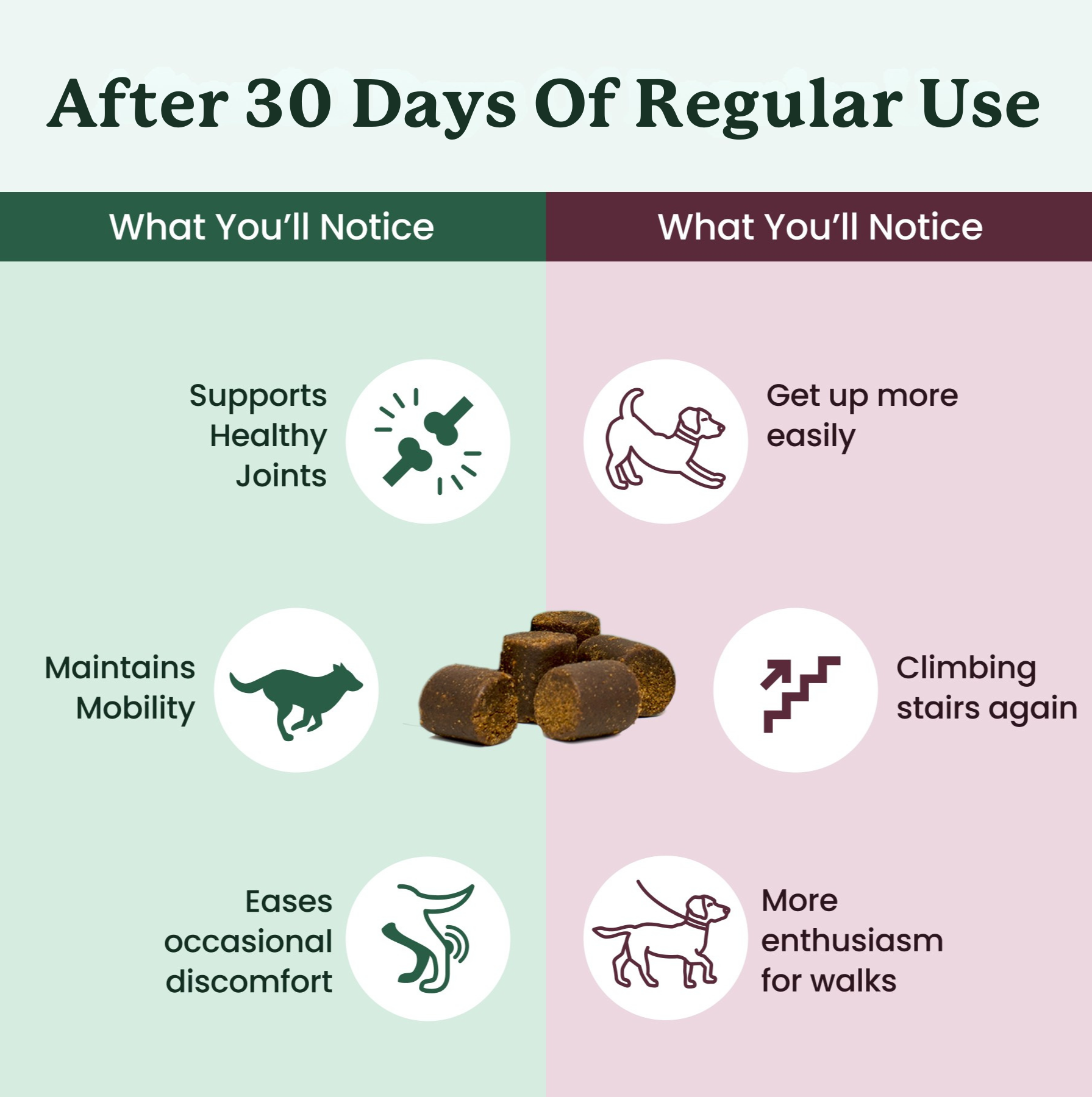It can be extremely concerning when your dog doesn't want to walk, or even refuses to stand up. Understanding the underlying cause is key to helping your pup feel comfortable and confident while walking. It could be simple stubbornness causing your dog to halt, or they could be struggling with an underlying mobility issue.
In this guide, we’ll explore the potential reasons your dog is refusing to walk or stand up, and we'll offer practical solutions to get your dog moving again.
Why Your Dog Might Refuse to Walk
There are various reasons why your dog may suddenly stop walking or refuse to start. Identifying the root cause is crucial for addressing the issue effectively.
Joint Pain and Arthritis
As dogs age, joint problems such as arthritis or hip dysplasia can make walking painful. Symptoms of joint discomfort include stiffness, limping, reluctance to get up after lying down, and an unusual gait. Even younger dogs can experience joint pain due to injuries or congenital issues.
To help: Provide a soft bed to ease pressure on joints and consider supplements like glucosamine or omega-3s (consult your vet first). For severe cases, medications or physical therapy prescribed by your veterinarian may be necessary.
Injuries or Paw Discomfort
Your dog might stop walking if they have an injury to their paw pads, nails, or legs. Common issues include cuts, burns from hot pavement, or something stuck between their paw pads. If your dog is licking their paws excessively or limping, these could be signs of injury.
To help: Inspect their paws and legs for visible wounds, swelling, or foreign objects. Clean any minor cuts with an antiseptic solution and protect the area with a bandage. For more serious injuries, contact your veterinarian for treatment.
Consider that your dog has experienced a joint injury if your examination of their paws doesn't provide any information. Joint injuries are often accompanied with symptoms like refusal to walk and limping.
Note from Dr. Randles, D.V.M.: Back injury (such as spondylosis or slipped disc) can result in reluctance to walk or abnormal gait. Severe abdominal pain (such as pancreatitis) can also make a dog crouch and reluctant to walk.
Behavioral Issues and Fear
Fear can also cause a dog to freeze or refuse to walk. This is especially common in rescue dogs, puppies, or dogs with past trauma. Environmental factors like loud noises, unfamiliar sights, or crowded areas can trigger their anxiety.
To help: Identify the source of fear and work on desensitizing your dog to it. Use treats, toys, or a soothing voice to build positive associations. For example, if they’re afraid of a trash can on the route, start by rewarding them for walking closer to it gradually. Patience is key here.
Leash Training Problems
Some dogs may resist walking if they’re not comfortable wearing a leash or harness. This can happen with dogs who are new to walking or those who associate the leash with negative experiences.
To help: Start by letting your dog wear their leash and harness indoors to get used to the sensation. Practice short walks around the house, rewarding good behavior with treats. Gradually introduce outdoor walks in quiet areas before moving to busier environments.
Fatigue or Overexertion
Overexertion can cause dogs to refuse to walk. Puppies and senior dogs are especially prone to getting tired quickly. Walking in extreme heat or cold can also sap your dog’s energy.
To help: Adjust the duration and intensity of your walks based on your dog’s age, breed, and health. For example, a short 10-minute walk might be sufficient for an older dog. Always carry water on walks to keep your dog hydrated.
How to Help Your Dog Start Walking Again
All dogs are different, so you may not be able to help all dogs walk with these tips. That said, the tips below cover a broad range of causes and solutions, so you should be able to see some improvement by following the guidelines below.
Step 1: Identify the Cause
Pay close attention to your dog’s behavior before and during walks. If they show signs of pain, injury, or fear, address those issues first. Keep a journal of their walking habits, including when and where they stop, to identify any patterns.
Step 2: Address Immediate Concerns
- Check for Injuries: Inspect your dog’s paws and legs for any visible signs of discomfort. Treat minor injuries at home or consult your vet if needed.
- Calm Anxieties: If your dog seems fearful, create a calm environment with familiar smells and sounds. Use treats or toys as positive reinforcement.
- Adjust the Route: Try walking in quieter, less stimulating areas to make the experience less overwhelming for your dog.
Step 3: Build Positive Associations
Make walking a rewarding experience for your dog by offering treats, praise, and playtime along the way. Carry their favorite toy or plan a route that leads to a fun destination, like a park or open field.
Step 4: Gradual Training
If your dog struggles with leash training, start with short walks and gradually increase the distance as they become more comfortable. Be patient and consistent, using positive reinforcement to encourage progress.
Preventing Walking Refusal in the Future
To ensure your dog enjoys their walks, consider the following tips:
- Regular Vet Checkups: Routine health checks can help identify and address joint issues or injuries early.
- Comfortable Gear: Invest in a well-fitting harness or collar to prevent discomfort during walks.
- Tailored Exercise: Customize your dog’s activity level based on their age, breed, and fitness. Avoid overexertion, especially in extreme weather.
- Consistent Training: Practice leash training regularly and reinforce good walking behavior with rewards.
When to See a Veterinarian
If your dog’s walking issues persist despite your efforts, it’s time to consult a veterinarian. Sudden lameness, signs of severe pain, or behavioral changes could indicate an underlying health condition that needs professional attention. A vet can provide a thorough examination and recommend treatments or therapies tailored to your dog’s needs.
Conclusion
Your dog might not want to walk for a number of reasons ranging from injury to anxiety. They may also be experiencing arthritis or another issue that's causing them pain when they move.
It's important to identify the root cause of this issue in order to make things better. If you're unable to quickly identify and resolve this issue at home, it's time to call your veterinarian so they can effectively help your dog get moving again.
Dog Refuses to Walk: FAQs
Why is my dog suddenly refusing to walk?
Sudden refusal to walk may indicate pain, injury, fear, or discomfort. Check for visible wounds, paw injuries, or anxiety triggers before assuming stubborn behavior.
Can arthritis make my dog stop walking?
Yes, arthritis can cause stiffness and joint pain that make walking difficult. Veterinary-prescribed medications and joint supplements may help improve comfort.
How do I know if my dog’s refusal to walk is behavioral or medical?
If your dog refuses walks in specific environments, fear or training may be the cause. If they limp, tremble, or show signs of pain, seek veterinary evaluation.
Should I force my dog to walk?
No. Forcing a dog to walk when they’re scared or in pain can worsen the issue. Instead, identify and address the root cause calmly and gradually.
When should I see a vet about my dog’s walking issues?
Consult a veterinarian if your dog’s reluctance to walk lasts more than 24–48 hours, is accompanied by pain, or appears suddenly without explanation.











